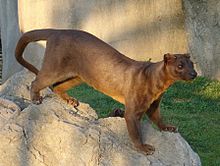| Fossa | |
|---|---|

| |
| At the Valencia Bioparc | |
| Scientific classification | |
| Domain: | Eukaryota |
| Kingdom: | Animalia |
| Phylum: | Chordata |
| Class: | Mammalia |
| Order: | Carnivora |
| Suborder: | Feliformia |
| Family: | Eupleridae |
| Genus: | Cryptoprocta |
| Species: | C. ferox[1]
|
| Binomial name | |
| Cryptoprocta ferox[1] Bennett, 1833
| |

| |
| Distribution of Cryptoprocta ferox (red-shaded area)[2] | |
| Synonyms | |
| |
The fossa (Cryptoprocta ferox; /ˈfɒsə/ FOSS-ə or /ˈfuːsə/ FOO-sə;[3] Malagasy: [ˈfusə̥]) is a slender, long-tailed, cat-like mammal that is endemic to Madagascar. It is a member of the carnivoran family Eupleridae.
The fossa is the largest mammalian carnivore on Madagascar and has been compared to a small cougar, as it has convergently evolved many cat-like features. Adults have a head-body length of 70–80 cm (28–31 in) and weigh between 5.5 and 8.6 kg (12 and 19 lb), with the males larger than the females. It has semi-retractable claws (meaning it can extend but not retract its claws fully) and flexible ankles that allow it to climb up and down trees head-first, and also support jumping from tree to tree. A larger relative of the species, Cryptoprocta spelea, probably became extinct before 1400.
The species is widespread, although population densities are usually low. It is found solely in forested habitat, and actively hunts both by day and night. Over 50% of its diet consists of lemurs, the endemic primates found on the island; tenrecs, rodents, lizards, birds, and other animals are also documented as prey. Mating usually occurs in trees on horizontal limbs and can last for several hours. Litters range from one to six pups, which are born altricial (blind and toothless). Infants wean after 4.5 months and are independent after a year. Sexual maturity occurs around three to four years of age, and life expectancy in captivity is 20 years. The fossa is listed as a vulnerable species on the IUCN Red List. It is generally feared by the Malagasy people and is often protected by their fady taboo. The greatest threat to the fossa is habitat destruction.
Its taxonomic classification has been controversial because its physical traits resemble those of cats, yet other traits suggest a close relationship with viverrids. Its classification, along with that of the other Malagasy carnivores, influenced hypotheses about how many times mammalian carnivores have colonized Madagascar. With genetic studies demonstrating that the fossa and all other Malagasy carnivores are most closely related to each other forming a clade, recognized as the family Eupleridae, carnivorans are now thought to have colonized the island once, around 18–20 million years ago.
- ^ Cite error: The named reference
MSW3was invoked but never defined (see the help page). - ^ a b c Hawkins, F. (2016). "Cryptoprocta ferox". IUCN Red List of Threatened Species. 2016: e.T5760A45197189. doi:10.2305/IUCN.UK.2016-1.RLTS.T5760A45197189.en. Retrieved 24 January 2022.
- ^ Cite error: The named reference
2000Crokewas invoked but never defined (see the help page).
